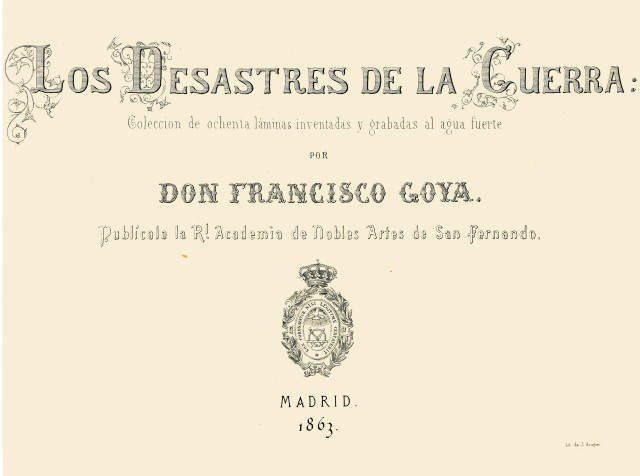- EN
Log in
- Live Auctions
- Past auctions
- More
- Gallery
- Art Dealing
- Publishing
- Kornfeld today
- The Story of Kornfeld
- Information














Fuendetodos 1746 - 1828 Bordeaux
1808-1823, with revisions from 1863
Etchings with slight reworking in aquatint
25.4x34.5 cm, book cover. All sheets in the paper size 24.3x32.8 cm, all with wide margins around the platemarks
Harris 121-200/III/1/a (of 7), before the title correction at sheet 9
Collection William Stirling of Keir (1818-1878)
Shickman Gallery, New York, acquired there in 2006 by
International Private Collection
In the original thread stitching of a 19th century leather binding, with cover printed in gold, the book pages with gilt edges and embossed title "DESASTRES DE LA GUERRA POR F. GOYA MADRID 1863". Title and cover sheets slightly foxed, the prints impeccable
The set "Los desastres de la guerra" was only printed in 1863 in the 1st edition and comprises 80 sheets of etchings with slight revisions in aquatint. There were only individual proofs of all the plates during Goya's lifetime. The circumstances of the time meant that the planned publication of the series "Los desastres de la guerra" could not take place during Goya's lifetime, due to the explosive domestic political nature of the depictions. Before Goya's emigration to Bordeaux in 1824, he gave a complete set of the proofs to his friend Ceán Bermúdez in Madrid, to which he added a handwritten title. 80 of the copper plates remaining in Madrid were bought by the Calcografia in Madrid in 1862, covered with light aquatint in 1863, numbered throughout at the top left and published by the Royal Academy in Madrid as the first edition of the series.
The set is divided into three thematic sections/groups:
A) 41 sheets painted from 1808 to 1814 under the theme of depictions of war and atrocities during war, inscribed by Goya "Fatales consequencias de lasangriente guerra en España con Buonaparte (guerra)".
B) 17 sheets were made in the winter of 1811/1812 under the theme Depictions and Scenes of the Famine in Madrid in the Winter of 1811 to 1812, inscribed by Goya as "Fatales consequencias de la sangriente guerra en España con Buonaparte (hambre)
C) 22 created from 1820 to 1823 as a group with allegorical sheets, called by Goya "y otros caprichos enfáticos", which were added as a late addition to the series
The copy offered here is an early 1st edition from 1863, published by the "Real Academia de Nobles Artes de San Fernando" in Madrid. It comprises 80 sheets of graphics, the title page and the preface to the 1st edition of 1863. 32 sheets are printed on paper with watermark "J.G.O. with palmette", as desired for this 1st edition.
This early edition of the 1st edition manifests itself in "sheet 9", which is present before the correction of the title. Harris lists editions with leaves before the title corrections with "a" and writes: "The titles were corrected progressively, the last to be corrected was that on plate 9". Copies with titles not yet corrected are the earliest, the best in print quality and are especially sought after
1808-1823, mit Überarbeitungen von 1863
Radierungen mit leichter Überarbeitung in Aquatinta
25,4x34,5 cm, Bucheinband. Sämtliche Blätter in der Papiergrösse von 24,3x32,8 cm, alle mit breitem Rand um die Plattenkanten
Harris 121-200/III/1/a (v. 7), vor der Titelkorrektur bei Blatt 9
Slg. William Stirling of Keir (1818-1878)
Shickman Gallery, New York, dort 2006 erworben von
Internationale Privatsammlung
In der ursprünglichen Fadenheftung eines Lederbandes des 19. Jahrhunderts, mit Deckelaufdruck in Gold, die Buchseiten mit Goldschnitt und geprägtem Titel "DESASTRES DE LA GUERRA POR F. GOYA MADRID 1863". Titel und Deckblätter leicht stockfleckig, die Drucke tadellos
Die Folge "Los desastres de la guerra" wurde erst 1863 in der 1. Ausgabe gedruckt und umfasst 80 Blatt Radierungen mit leichten Überarbeitungen in Aquatinta. Von allen Platten gab es zu Lebzeiten Goyas nur einzelne Probedrucke. Die Zeitumstände brachten es mit sich, dass die geplante Herausgabe der Folge "Los desastres de la guerra" während Goyas Lebzeiten, bedingt durch die innenpolitische Brisanz der Darstellungen, nicht erfolgen konnte. Vor Goyas Emigration nach Bordeaux im Jahr 1824 übergab er seinem Freund Ceán Bermúdez in Madrid einen kompletten Satz der Probedrucke, die er mit einem handschriftlichen Titel versah. 80 der in Madrid verbliebenen Kupferplatten wurden 1862 von der Calcografia in Madrid gekauft, 1863 mit leichter Aquatinta überzogen, durchgehend oben links nummeriert und von der königlichen Akademie in Madrid als Erstauflage der Folge publiziert
Die Folge ist aufgeteilt in drei thematische Abteilungen/Gruppen:
A) 41 Blatt entstanden von 1808 bis 1814 unter dem Thema Kriegsdarstellungen und Grausamkeiten während des Krieges, von Goya "Fatales consequencias de lasangriente guerra en España con Buonaparte (guerra)" bezeichnet
B) 17 Blatt entstanden im Winter 1811/1812 unter dem Thema Darstellungen und Szenen von der Hungersnot in Madrid im Winter 1811 bis 1812, von Goya mit "Fatales consequencias de la sangriente guerra en España con Buonaparte (hambre)" bezeichnet
C) 22 entstanden von 1820 bis 1823 als Gruppe mit allegorischen Blättern, von Goya "y otros caprichos enfáticos" genannt, die als späte Ergänzung der Folge zugefügt wurden
Das hier angebotene Exemplar ist eine frühe 1. Ausgabe von 1863, publiziert durch die "Real Academia de Nobles Artes de San Fernando" in Madrid. Sie umfasst 80 Blatt Graphik, das Titelblatt und das Vorwort zur 1. Ausgabe von 1863. 32 Blätter sind auf Papier mit Wasserzeichen "J.G.O. mit Palmette" gedruckt, wie für diese 1. Ausgabe gewünscht
Die vorliegende Frühausgabe der 1. Ausgabe manifestiert sich im "Blatt 9", das noch vor der Korrektur des Titels vorliegt. Harris führt Auflagen mit Blättern vor den Korrekturen der Titel mit "a" auf und schreibt: "The titles were corrected progressively, the last to be corrected was that on plate 9". Exemplare mit noch nicht korrigierten Titeln sind die frühesten, in der Druckqualität die besten und werden besonders gesucht















